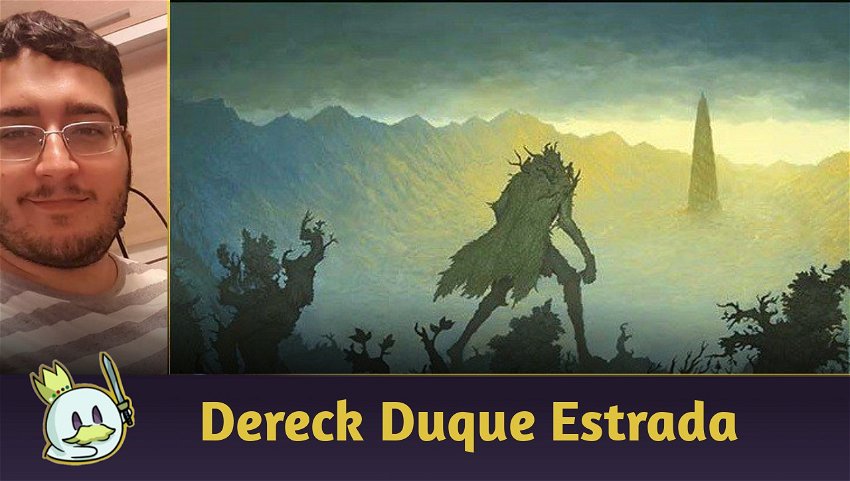Introduction
With the arrival of Lord of the Ring: Tales of the Middle-Earth (LOTR), some lists are starting to emerge exploring some of the set 's mechanics to test their efficiencies.
About the Alchemy format
Alchemy is a rotating format that follows the Standard format, but it contains sets and cards of its own and there is a list of cards that have their effects changed to better balance the Metagame.
It exists only at Magic Arena and has already had a presence in the competitive scene, being the focus of some tournaments.
Ad
If you would like to know more about Alchemy, we have an article that deals with all questions about Alchemy.
About Jund Ramp
Decklist
The purpose of the deck is to reach the range between 7 and 9 mana as soon as possible to cast spells that stabilize or generate an immediate impact on the board to unbalance the game for your side.
That is, what we are looking for is one of the wincons that, once resolved, practically guarantees us victory.
Winconditions

Etali, Primal Conqueror is one of the main wincons to cast, being one of the main reasons for ramping, and can find permanents or removals with its ability.
Last March of the Ents is an addition to the deck that arrives with LOTR. The great advantage of the card is that, if you don't have anything on the board, it still allows you to put all the creatures in your hand on the battlefield at once, and if you have any creatures, you'll still draw some cards. Also, not being countered makes the card an excellent option for ramping.

Titan of Industry and Portal to Phyrexia are well-known cards that generate a lot of impact when they enter the battlefield, tending to impact the board the longer they stay.
Phyrexian Fleshgorger is a multipurpose card that can be made as a prototype and save some life points early in the game, but it won't be as common due to the mana base situation, being usually cast for its full cost - spawning a creature 7/5 with menace and lifelink, which can heal some life and take out some creatures in the process.
Another point for choosing the Phyrexian is because it is not the target of the format's current best removal, Go for the Throat, making it harder for black-based decks to deal with it.
Having presented our “goals”, let's go to the mechanics to achieve them!
The Ramps

Delighted Halfling is the ramp that comes with LOTR. Although most of the time the card generates colorless mana, its ability to not allow legendary spells to be countered when using its colored mana is very interesting for resolving Etali, Primal Conqueror or Doors of Durin.

The other pieces are already more common to the format, such as Topiary Stomper, Forceful Cultivator, Foundry Groundbreaker and Invasion of Zendikar. It's important to pay close attention to the lands we are looking for, to ensure that we have the necessary colors to cast the greater spells.
And when using Foundry Groundbreaker, remember that the conjured lands will be colorless, so the sacrificed land must be of a color that we have other options on how to generate.
Removals
To have a more consistent strategy, it is necessary to use some removals to hold the first turns to structure the setup.
Ad

Although Portal to Phyrexia is a removal, I won't be counting it, after all we are considering the card as our wincon. With that, we only have two types of removals: Go for the Throat which is one of the main removals of the format, and usually positions itself on the curve between ramps, allowing it to deal with threats while adjusting the setup.

Another removal option is a LOTR card that has been compared to The Meathook Massacre: Spiteful Banditry actually has similar characteristics, possibility of doing the necessary damage on the board for its variable cost, two mana specifics of the same color in the cost.
But what interests us most, in addition to the global effect, is the possibility of creating a treasure if one or more of your opponent's creatures die. That is, we play a sweeper and still increase our mana availability, being perfect for strategy.
Alternative strategies
When I found the list it ran 4 Hew the Entwood, the strategy was to either ramp to the wincon or sacrifice the lands and put a Portal to Phyrexia or Phyrexian Fleshgorger as early as possible in the game.
I don't like this type of bet very much, if it is not effective, the game is over.
Also, I often found myself in moments where I had to cast it too soonm or play with dead cards in my hand.
So, I decided to remove the card, and with the vacant positions I added two Invasion of Zendikar, as I felt that there was a little bit left to reach the top of the curve and that really gave more stability to the deck, closing with a copy of Doors of Durin, which allows you to put creatures on the battlefield bypassing the cost and dodging counterspells.

With these changes, it made more sense to increase the presence of black mana in the deck, so I changed the removal from Volcanic Spite to Go for the Throat.
Also, I increased the number of lands, playing with 25 to guarantee my initial drops.
Playing with the Deck
With the focus of the deck being on ramps, it seeks to have these alternatives from turn 1, having pieces on curve 1 to 4 that allow ramping, with the vast majority focused on increasing the availability of lands and closing the game with big spells like Etali, Primal Conqueror, Phyrexian Fleshgorger or Titan of Industry.
Facing Aggro Decks
Against more aggressive decks, it's important to intersperse the ramp with removals, using creatures to reduce the opponent's momentum and preserve your life total until you can fit the deck's decisive permanents.
In these matchups, Spiteful Banditry is particularly efficient, leveraging all trades and removals - thus increasing the mana available to develop the game.
Phyrexian Fleshgorger is another functional piece in the deck due to its lifegain, being able to recover and stabilize games.

Ad
Sideboard
For these matchups, Cut Down can be very precious, replacing Duress that will have less impact in this match.
Brotherhood's End is a low-cost sweeper option that's good for taking on this deck type.
Portal to Phyrexia, although it can be very efficient, it is too slow to start, with the two copies being removed, making room for the fourth Phyrexian Fleshgorger which allows a lifegain alongside a 3/3.
Tear Asunder is very efficient against decks that run Wedding Announcement and Ossification, in these cases, two copies are efficient, so you don't have too many in your hand, being removed from the deck the Doors of Durin and Last March of the Ents.
IN

OUT

Facing Control Decks
Against control-focused decks, it's important to perform resource maintenance, cards like Farewell are absurdly efficient, removing all the high-impact pieces from the deck.
Another point of concern is The One Ring, as it is a card with a colorless mana cost, it is being used in all midrange and control lists so far.
For these matchups, Duress is an alternative to avoid problematic cards that can bring the opponent back into the game.
Using Phyrexian Fleshgorger in its Prototype mode is a way to make the deck more aggressive and force the opponent to worry more about our pressure, while you look for alternatives to close the ramp setup.
Delighted Halfling and Doors of Durin are ways to get around the counterspells and ensure our advantage.

Sideboard
Duress is the first option to deal with sweepers, counters and The One Ring, thus avoiding a wasted attack turn.
Tear Asunder presents itself as a solution to resolve The One Ring. Orcish Bowmasters is also an option to take advantage of the card advantage provided by The One Ring to add damage and gain bodies on the board.
An alternative is to use Liliana of the Veil, which works to escape removals and attack the opponent's hand, reducing resources to help us in the topdeck mode, it can be used as an alternative to a Ramp like Foundry Groundbreaker.
Tyrranax Rex is an aggressive option that targets a direct hit as soon as it enters the battlefield, forcing an excessive amount of mana to deal with it. It can be a viable alternative in place of an Etali, Primal Conqueror.
Other options to leave are: Portal to Phyrexia, Go for the Throat, Invasion of Zendikar, Spiteful Banditry.
IN

OUT

Facing Combo Decks
Against combo decks, the main action is to attack the opponent's hand or destroy the key pieces of the combo.
Ad
Duress is fundamental in these matchups, either to remove the piece from the combo, or to delay the process of finding the pieces.
Titan of Industry can have an interesting impact, dealing with Enchantments or Artifacts that are part of their combo.
Go for the Throat is a removal that can stop effects that rely on creatures to perform a looping.
Sideboard
Liliana of the Veil and Duress are the main cards to enter these games, being alternatives to reduce the opponent's hand while you ramp.
Orcish Bowmasters is an option when the opponent draws a lot to find the pieces, helping to sap life totals and strengthen the board.
Tear Asunder will most likely make the list to go against The One Ring which is currently the best draw for combo/control decks.
Options that can be sided out are Etali, Primal Conqueror, Portal to Phyrexia, Go for the Throat, Spiteful Banditry, and Invasion of Zendikar
IN

OUT

Conclusion
With the tests I did with the deck, it turned out to be quite fun, able to deal with threats. However, the field is becoming somewhat repetitive, decks built around The One Ring and Oracle of the Alpha are constant in the format, and much because of this change, I transformed the initial list which would be a Gruul, with a slight splash to black, for a Jund version, with a significant presence of black mana. This allows attacks on the opponent's hand, preventing the rings from finding others and starting to provide survivability to the opponent until the moment we stabilize the board.
Obviously, the deck could gain consistency with the use of cards like Fable of the Mirror-Breaker, The One Ring and Crucias, Titan of the Waves, but the goal was to try to escape from it and bring different game plans, with different cards and still provide a way to confront the main ranked decks.
In addition, the experience with the new cards of Lord of the Ring: Tales of the Middle-Earth was very positive in general, having a very interesting potency for Alchemy. However, there is a risk of an exaggerated presence of The One Ring due to its colorless cost, which allows it to be easily placed in any deck and guaranteeing one more turn with its protection, in addition to a large wave of Black-based decks due to the Orcish Bowmasters, which can be placed as a possible brake for the artifact.
Now it's a matter of waiting to see if the meta will be polarized in this way.
Hope you enjoyed the article.
For questions, the comment section is just ahead, feel free to use!
See you in the next article!









— 评论0
成为第一个发表评论的人